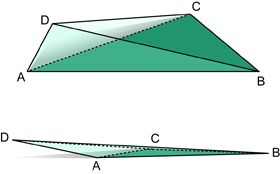Aspect ratio refers to the relationship between width and height of a mesh element. When the aspect ratio is too high, the tetrahedron (tetra) may be flat or distorted, which will affect the accuracy of results.
Tetrahedra (tetra) with a high aspect ratio are detected with the Mesh Statistics:  ().
().
They can also be detected with the Mesh Repair Wizard:  ().
().
Description
The mathematical analysis of a model is based on the assumption that the mesh is composed of uniform, equilateral tetras. In practice the mesh will be comprised of tetras that range form the ideal equilateral tetras to the extremely distorted tetras with the potential to significantly effect the results. As such it is important to reduce the number of distorted tetras as far as practical. Aspect Ratio is the most common method used to measure the mesh quality. Other methods are Internal Long Edges and Tetra with Extreme Angles between Faces.
Ensuring sensitive areas such as gates, areas with large geometry changes or gas channels (in a gas-injection simulation) are meshed with low aspect ratio elements is particularly important.

Low Aspect Ratio tetra (top) and High Aspect Ratio tetra (bottom)
A perfect tetra with equal edge lengths has an aspect ratio of 1. A flat tetra will have a ratio of infinity.
It is recommended that the maximum aspect ratio be reduced to below 30 in as much of the mesh as possible. The recommended maximum aspect ratio value is 50; the absolute maximum value is 500
Recommended action
Always check the aspect ratio of the mesh :  (). The Mesh Repair Wizard:
(). The Mesh Repair Wizard:  () can be used to repair the majority of these elements.
() can be used to repair the majority of these elements.